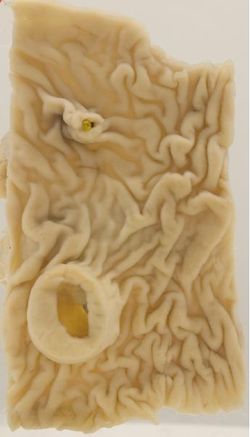Duodenum - Anatomy & Physiology
Introduction
The duodenum is the proximal part of the small intestine and extends from the pylorus of the stomach to the jejunum. It has descending and ascending portions and both portions have digestive and absorptive functions.
Structure
The descending duodenum passes out of the pylorus of the stomach (on the right side of the abdomen) and has a sigmoid flexure. It passes towards the right abdominal wall and rises dorsally. In its passage, it is related dorsally to the right lobe of the pancreas, ventrally to the jejunum and medially to the ascending colon and caecum. At a point between the right kidney and pelvic inlet, it turns medially and cranially around the root of the mesentery to become the ascending duodenum. The point of turn is called the caudal flexure of the duodenum. The ascending duodenum is shorter and bends ventrally to enter the mesentery and becomes the jejunum. The mesoduodenum attaches the duodenum to the dorsal abdominal wall. Within the mesoduodenum is the right lobe of the pancreas. The pancreatic and bile ducts open into the duodenum. The bile duct and one of the pancreatic ducts discharge into the proximal part of the duodenum by separate major duodenal papillae. The second pancreatic duct discharges a little more distally on a smaller papilla. The cranial part of the descending duodenum is attached to the liver by the hepatoduodenal ligament. This is a remnant of the ventral mesogastrium in the embryo. The bile duct runs within the hepatoduodenal ligament.
Vasculature
The duodenum receives blood from the coeliac artery and the cranial mesenteric artery. Both are branches of the aorta. The cranial mesenteric vein drains blood from the duodenum into the portal vein. This blood, carrying the products of digestion, enters the liver.
Species Differences
Canine
The duodenum is about 25cm long in canine species. The mesoduodenum is relatively long.
Equine
The mesoduodenum is relatively short, so the duodenum is closely tethered in a constant position. The descending duodenum is attached to the base of the caecum. The descending duodenum runs caudally beneath the liver to the caudal pole of the right kidney where it has it's caudal flexure to become the ascending duodenum.
Ruminant
The mesoduodenum is relatively short. The first part of the descending duodenum rises almost vertically within the ribcage, in close apposition to the liver. It turns level with the tuber coxae. The first part of the duodenum is attached to the liver by the lesser omentum. The descending duodenum also provides attachment for the superficial and deep sheets of the greater omentum.
Porcine
The small intestine is comparable to the dog. The mesoduodenum is relatively long.
Links
Click here for more information on the Pathology of the Small and Large Intestine
| Duodenum - Anatomy & Physiology Learning Resources | |
|---|---|
To reach the Vetstream content, please select |
Canis, Felis, Lapis or Equis |
 Test your knowledge using flashcard type questions |
Duodenum anatomy |
 Selection of relevant videos |
Ruminant small and large intestine potcast Ruminant abdomen potcast Foal gastrointestinal tract potcast Lateral view of the feline thorax and abdomen potcast Female dog abdomen dissection Abdominal viscera of the horse dissection Equine left-sided abdominal and thoracic topography dissection Equine left-sided abdominal and thoracic topography dissection 2 Ovine large and small intestine dissection Porcine abdomen dissection |
Webinars
Failed to load RSS feed from https://www.thewebinarvet.com/gastroenterology-and-nutrition/webinars/feed: Error parsing XML for RSS
